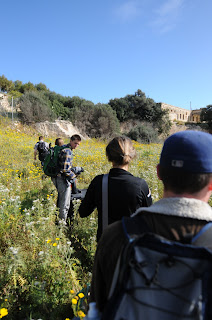Hi everyone! We've been working hard on producing maps and visualizations of some of the cisterns. I have been particularly interested in reconstructing medium sized features from stereo camera data (archways, stairs, bumps, etc.) in the Mediterranean Conference Center cistern that I made a sonar mosaic of the other day. To affix our stereo data to the rough SONAR generated models, first we have to make a map and reconstruction of the cistern.
The cistern was enormous, and our software can only support chunks of the larger models at any one time (well... before we use up 8 gigs of RAM and crash our software), so I have been working on the cistern piece by piece.
I captured some great stereo images in one of the main chambers of the cistern. From the 2D sonar mosaic the room doesn't look too interesting. However, from a 3D standpoint the chamber looks like a mushroom! Much more interesting! This is why 3D SONAR is so important to us and to our archaeologist friends.
Mediterranean Conference Center 2D Sonar Mosaic
Mediterranean Conference Center 3D Sonar Mosaic
I took the 3D sonar mosaic and converted from pixel space to 'blender space', and then from 'blender space' to meters. I then loaded the scans into our mapping algorithm to produce a 3D occupancy grid of the SONAR data. Here is the map which we will use to construct the final 3D mesh which will be a closed surface and will look much nicer!
Mediterranean Conference Center SONAR Occupancy Grid
So far this room in the map is about halfway through our visualization pipeline. We have a couple more steps to go in order to make it a pretty 3D graphic that people can use for study and learning. I intend to fuse some of the stereo data from this cistern into the model as well. The work on that front has been a little more difficult due to the underwater image noise and poor quality of our stereo hardware, but here are a couple of preliminary disparity maps that were processed (in the method described a day or two ago) from raw underwater captures on the stereo cams.
The plan is to add some of these features back into the meshes, so stay tuned for results on the computer graphics end in the next couple of days!
Footnote: Just for fun - Vanessa just posted this, but here is a picture of me driving the robot in this very cistern (in the deep dark depths of the paint closet) to give a little bit of context.



























